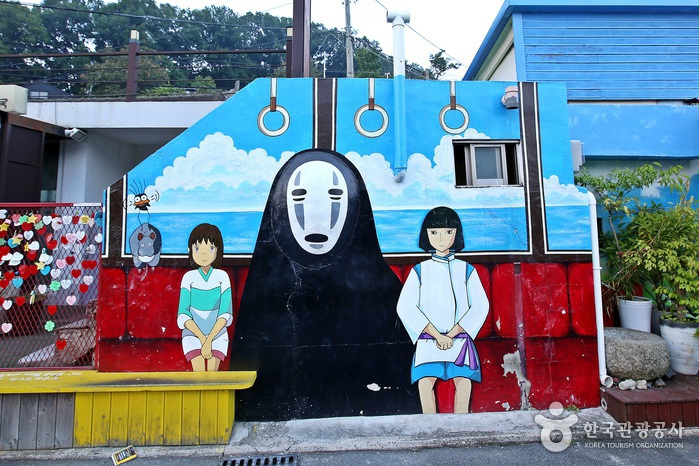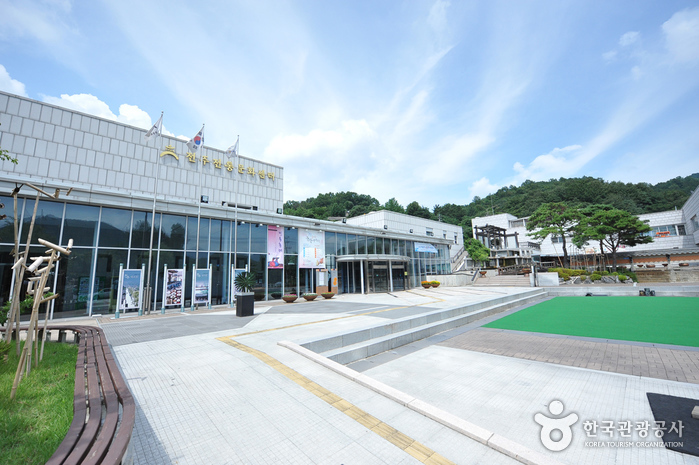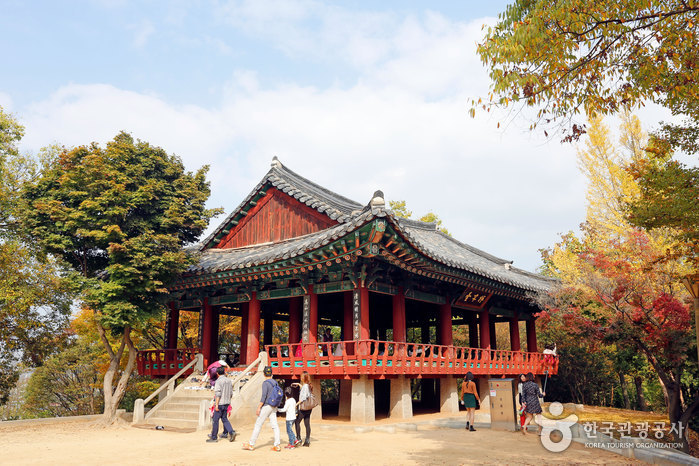Jaman Mural Village (자만마을 벽화갤러리)
135.9764423297257m 1 2024-05-02
Gyo-dong, Wansan-gu, Jeonju-si, Jeonbuk-do
Jaman Mural Village is located on a hillside across the road from Jeonju Hanok Village. The village was formed by Korean war refugees resettling where they could, and remained as a small village interlaced by narrow pathways until 2012. At that point, the village was enlivened with over 40 murals and became popular for photographs. Many of the houses have been converted into cafes, guesthouses, and restaurants.
Jaman Mural Village (자만벽화마을)
137.68661235578136m 1664 2024-04-07
1-10, Jamandong 1-gil, Wansan-gu, Jeonju-si, Jeonbuk-do
Jaman Mural Village is located in the ridge between Omokdae and Imokdae along the foot of Seungamsan Mountain’s Jungbawi Rock. Jeonju Hanok Village is also visible from the wide street. Although it is a fairly steep walk up to Jaman Village, visitors will be able to enjoy colorful murals painted on the buildings and walls along the way.
Bu Yong Heon [Korea Quality] / 부용헌 [한국관광 품질인증]
138.15201538991835m 11203 2024-04-07
149-3 , Hyanggyo-gil, Wansan-gu, Jeonju-si, Jeonbuk-do
+82-10-8875-8587
Buyongheon is a Hanok stay in Jeonju Hanok Village, Jeollabuk-do, right next to the Jeonju Hyanggyo Confucian School. Accomodation is comprised of Toenmaru Bang, Daecheong Maru Bang, Large Daecheong Maru Bang and Big Sarangchae. The room is neat and feels the beauty of blank space. A culture experience program includes traditional etiquette and hanji making, while the Jeonju Hanbyeok Cultural Center and the Confucian school are reachable on foot. Jeonju Station and Jeonju Express Bus Terminal are 10 to 15 minutes away by car.
Saranggadeuk[Korea Quality] / 사랑가득[한국관광 품질인증]
141.77749962904676m 2401 2024-04-07
149-8 , Hyanggyo-gil, Wansan-gu, Jeonju-si, Jeonbuk-do
+82-10-7451-3355
Located in Jeonju Hanok Village, Saranggadeuk is a traditional hanok that was renovated from a traditional hanok built in 1900, which retains the elegance of hanok architecture in its toenmaru (narrow wooden porch), rafters, and eaves. The hotel has six guest rooms, including a spacious ondol (underfloor heated) room with an interior finished in cypress wood that emits a subtle scent. Each of the rooms has a bathroom with a shower, and the Cherry and Rose rooms are recommended for couples, while the Azalea rooms are recommended for groups. Breakfast is served with freshly baked toast, seasonal fruits, and coffee in the room, and cooking is not permitted.
Yedawon [Korea Quality] / 예다원 [한국관광 품질인증]
161.49432129639615m 184 2024-04-07
85-34 , Hyanggyo-gil, Wansan-gu, Jeonju-si, Jeonbuk-do
+82-63-228-8218, +82-10-3376-8987
Positioned at the foot of Omokdae in Jeonju, Jeollabuk-do, Yedawon is a hanok stay which offers guests a unique experience of traditional hanok life. Guestrooms have exposed timbers, walls lined with Korean paper, and framed works of calligraphy. The Lotus Room boasts a beautiful 8-panel folding screen with painted landscape, and large ink-and-wash artworks on the wall. The traditional experience program includes tea ceremonies, natural dyeing, hanji making and rice-cake making. Jeonju Hyanggyo Confucian School, Jeonju Hanbyeok Cultural Cente and Gyeonggijeon Shrine are all reachable on foot.
Today [Korea Quality]오늘[한국관광 품질인증]
168.5852547252541m 0 2024-04-07
155-26 , Hyanggyo-gil, Wansan-gu, Jeonju-si, Jeonbuk-do
+82-507-1348-1522
Today is a private hanok stay near the old Hyanggyo Confucian school in Jeonju, Jeollabuk-do. Accommodation consists of two bedrooms, living room, two bathrooms and a kitchen. There’s an indoor jacuzzi which guests will find soothes away weariness - especially with added Dead Sea salt (provided). The living room has a beam projector for movies; alternatively guests can play traditional games such as yutnori, gonggi, and gogu. In the backyard, there is a swimming pool, and also a fire pit where guests can make a barbecue and chat while staring at the fire.
Jeonju Hanbyeok Culture Center (전한벽문화관)
207.76004541364463m 33768 2023-04-06
20, Jeonjucheondong-ro, Wansan-gu, Jeonju-si, Jeonbuk-do
Jeonju Hanbyeok Culture Center offers visitors a chance to both witness and experience a series of various cultural traditions. Pansori, minyo, traditional dances and performances are all open for the public to enjoy throughout the year. Jeonju’s most famous food, bibimbab (rice with mixed vegetables) and other Korean cuisine can be sampled at the Traditional Restaurant Hall. Traditional wedding ceremonies are also held at the Traditional Wedding Hall.
Yangsajae [Korea Quality] / 문화공간 양사재 [한국관광 품질인증]
214.492700553259m 14399 2024-04-07
40 , Omokdae-gil, Wansan-gu, Jeonju-si, Jeonbuk-do
+82-63-282-4959
In Joseon times Yangsajae hanok stay in Jeonju Hanok Village, Jeollabuk-do, was part of the Jeonju hyanggyo or local Confucian school - a place of study and scholarship. Later the poet Lee Byeong-ki lived and wrote here, and later still, in 1987, the house became a public elementary school. Since 2002 it has been a hanok stay dedicated to cultural tourism and promotion of local history and traditions.
Omokdae and Imokdae Historic Sites (오목대와 이목대)
238.41555812894538m 27949 2024-04-07
55 Girin-daero, Wansan-gu, Jeonju-si, Jeonbuk-do
+82-63-281-2114
Omokdae Historic Site is located on top of a steep hill and is one of the places where Yi Seong-gye, who later became King Taejo, the first king of the Joseon dynasty, stopped to celebrate his victory on his way home from a war against the Japanese army at Unbong Peak of Hwangsan Mountain. Across the bridge from Omokdae is Imokdae Historic Site, situated at the foot of Seungamsan Mountain. Approximately 80 meters downhill from Imokdae are memorial stones and a building where Mokjo, the great-great-grandfather of King Taejo, once used to live. The engraved letters on the stones are the handwritings of Emperor Gojong. Mokjo moved to Hamgyeongdo as a result of a dispute with the then minister of Jeonju, an incident which King Taejo believed to have laid the foundation for him to shape the Joseon dynasty.


![Bu Yong Heon [Korea Quality] / 부용헌 [한국관광 품질인증]](http://tong.visitkorea.or.kr/cms/resource/94/2596794_image2_1.jpg)
![Saranggadeuk[Korea Quality] / 사랑가득[한국관광 품질인증]](http://tong.visitkorea.or.kr/cms/resource/57/3022057_image2_1.jpg)
![Yedawon [Korea Quality] / 예다원 [한국관광 품질인증]](http://tong.visitkorea.or.kr/cms/resource/91/2594991_image2_1.jpg)
![Today [Korea Quality]오늘[한국관광 품질인증]](http://tong.visitkorea.or.kr/cms/resource/61/2948861_image2_1.jpg)

![Yangsajae [Korea Quality] / 문화공간 양사재 [한국관광 품질인증]](http://tong.visitkorea.or.kr/cms/resource/41/2999041_image2_1.jpg)

 English
English
 한국어
한국어 日本語
日本語 中文(简体)
中文(简体) Deutsch
Deutsch Français
Français Español
Español Русский
Русский